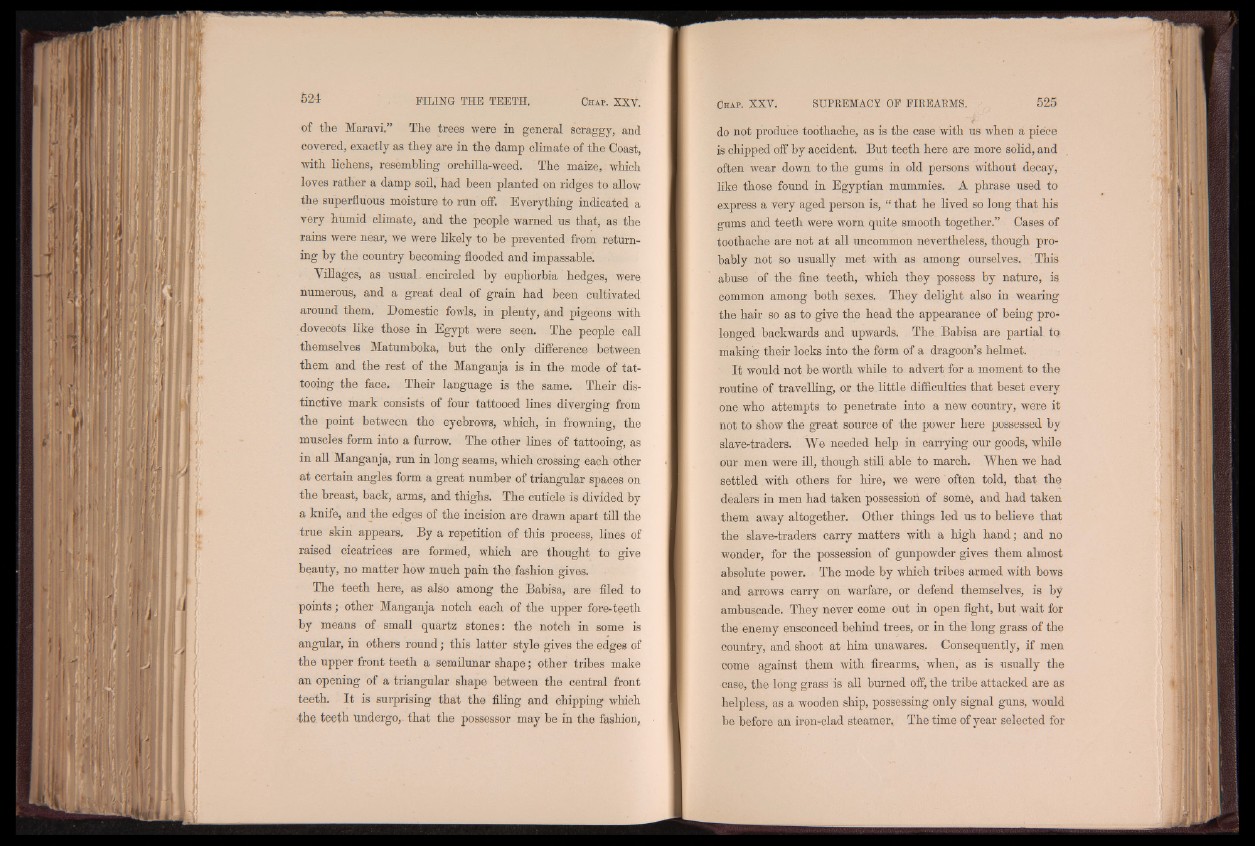
of the Maravi.” The trees were in general scraggy, and
covered, exactly as they are in the damp climate of the Coast,
with lichens, resembling orchilla-weed. The maize, which
loves rather a damp soil, had been planted on ridges to allow
the superfluous moisture to run off. Everything indicated a
very humid climate, and the people warned us that, as the
rains were near, we were likely to be prevented from returning
by the country becoming flooded and impassable.
Villages, as usual, encircled by euphorbia hedges, were
numerous, and a great deal of grain had been cultivated
around them. Domestic fowls, in plenty, and pigeons with
dovecots like those in Egypt were seen. The people call
themselves Matumboka, but the only difference between
them and the rest of the Manganja is in the mode of tattooing
the face. Their language is the same. Their distinctive
mark consists of four tattooed lines diverging from
the point between the eyebrows, which, in frowning, the
muscles form into a furrow. The other lines of tattooing, as
in all Manganja, run in long seams, which crossing each other
at certain angles form a great number of triangular spaces on
the breast, back, arms, and thighs. The cuticle is divided by
a knife, and the edges of the incision are drawn apart till the
true skin appears. By a repetition of this process, lines of
raised cicatrices are formed, which are thought to give
beauty, no matter how much pain the fashion gives.
The teeth here, as also among the Babisa, are filed to
points; other Manganja notch each of the upper fore-teeth
by means of small quartz stones: the notch in some is
angular, in others round; this latter style gives the edges of
the upper front teeth a semilunar shape; other tribes make
an opening of a triangular shape between the central front
teeth. I t is surprising that the filing and chipping which
•the teeth undergo, that the possessor may be in the fashion,
do not produce toothache, as is the case with us when a piece
is chipped off by accident. But teeth here are more solid, and
often wear down to the gums in old persons without decay,
like those found in Egyptian mummies. A phrase used to
express a very aged person is, “ that he lived so long that his
gums and teeth were worn quite smooth together.” Cases of
toothache are not at all uncommon nevertheless, though probably
not so usually met with as among ourselves. This
abuse of the fine teeth, which they possess by nature, is
common among both sexes. They delight also in wearing
the hair so as to give the head the appearance of being prolonged
backwards and upwards. The Babisa are partial to
making their locks into the form of a dragoon’s helmet.
I t would not be worth while to advert for a moment to the
routine of travelling, or the little difficulties that beset every
one who attempts to penetrate into a new country, were it
not to show the great source of the power here possessed by
slave-traders. We needed help in carrying our goods, while
our men were ill, though still able to march. When we had
settled with others for hire, we were often told, that the
dealers in men had taken possession of some, and had taken
them away altogether. Other things led us to believe that
the slave-traders carry matters with a high hand; and no
wonder, for the possession of gunpowder gives them almost
absolute power. The mode by which tribes armed with bows
and arrows carry on warfare, or defend themselves, is by
ambuscade. They never come out in open fight, but wait for
the enemy ensconced behind trees, or in the long grass of the
country, and shoot at him unawares. Consequently, if men
come against them with firearms, when, as is usually the
case, the long grass is all burned off, the tribe attacked are as
helpless, as a wooden ship, possessing only signal guns, would
be before an iron-clad steamer. The time of year selected for